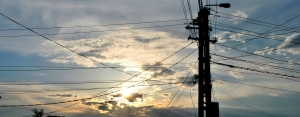Staying Grounded: Safely working with wind power
 Wind energy might still be a growing industry, but the hazards of the job aren’t unique. Wind energy workers are exposed to various dangers, not only because of the heights they work at, but also because of the power they’re helping generate. Whether it’s from human error or mother nature, anything from induced voltage and backfeed to static electricity and lightning all pose serious risk factors, which can result in critical injury or death.
Wind energy might still be a growing industry, but the hazards of the job aren’t unique. Wind energy workers are exposed to various dangers, not only because of the heights they work at, but also because of the power they’re helping generate. Whether it’s from human error or mother nature, anything from induced voltage and backfeed to static electricity and lightning all pose serious risk factors, which can result in critical injury or death.
Protecting workers should be the main priority at any jobsite, and employees should fully understand and engage in workplace safety to protect themselves from hazards. Ensuring fall protection measures are in place, it’s just as important to keep power in check as at any point a line could become energized. This begins with staying safely grounded.
Putting safety first
Staying safely grounded includes abiding by standards and working with the correct equipment, as well as proper inspections, cleaning, storage, maintenance, and re-certification. However, completing a job safely should always begin with the knowledge and understanding of a company’s Safe Work Practices, including a hazard assessment prior to work (see OSHA 29 CFR 1910.269(a)(3) & .269(c)). This will help guide workers through the completion of a job in a safe and efficient manner—from beginning to end—and will include information on the proper grounding practices.
Grounding standards
Grounding equipment must be capable of conducting the maximum fault current, which could flow at the point of grounding, for the time necessary to clear the fault. When custom building ground sets, it’s important to utilize a professional testing facility that specifically meets the needs of a jobsite. It’s not a time to cut corners. Protective grounding should have an electrical impedance low enough to cause the immediate operation of protective devices, in the case of accidental operation of the lines or of any equipment (OSHA 29CFR 1910.269(n)(4)).
Installation and removal of protective grounding should always be done with live-line tools, with the ground-end connection installed first and removed last (OSHA 29CFR 1910.269(n)(6)). Live-line tools should be properly inspected before use for any damage that could inhibit their protective properties. Any equipment that has suspected damage should be removed from use in the field, and sent to a professional testing facility (American Society for Testing and Materials/ASTM 711-02, 8.1).
According to John Grzywacz, Professor Emeritus of the OSHA National Training Institute, “Most utility accidents and fatalities with respect to line contact are a result of a lack of appropriate PPE and insulated line cover-up, or a lack of appropriate grounding.”
Choosing wisely
When building sets, a variety of grounding clamps (including smooth jaws, pressure terminals, snap-on clamps, and bronze body styles with serrated jaws) and ferrules (shrouded and un-shrouded) are available. Clamps and ferrules are furnished in different types and classes, or grades. Bear in mind that the wrong clamp can fly off whatever it’s clamped to under fault conditions, so choose wisely based on the job.
Cable can be purchased with colored jackets or clear. Colored jackets, such as yellow, can offer better visibility of the ground set; whereas, a clear jacket offers the reassurance of seeing the cabling inside, making inspection easier. Ground cables are stated in American Wires Gage numbers (AWG), and are also classified by type. Cables should be stocked in various lengths to accommodate different applications. Ground clusters installed with excessive cable length can whip violently under fault conditions, causing serious injury or worse. Specifications for temporary grounding equipment can be found in ASTM F855-1990.
Daily inspections
Each and every day before use, inspection of clamps, cables, support studs, shrink tubing, and ferrules should occur to ensure there isn’t any structural damage. Clamps should be free of loose parts, sharp edges, splits, and cracks, and should be operated smoothly and easily by hand (see ASTM F855-09,10,23,36). Carefully inspect the area where the cable meets the ferrule for any breakage. Also examine the cable jacket for any corrosion (indicated by swollen or soft spots), any flattened or smashed sections, or any cuts or breakage in the cable jacket.
Damaged ground set should be taken out of use and sent in for repair and re-certification. Though damage can sometimes be easily identified, regular wear and tear, extreme voltage, and moisture can also cause unseen impairment. For this reason, an industry best practice is to establish planned repair and re-certification intervals, based on the type and frequency of work.
Cleaning & storage
Dirt and water can actually conduct electricity. Moreover, the everyday petroleum-based products that grounds come in contact with can damage the integrity of a ground set, reducing protective properties. So, regular cleaning of ground sets are needed to maintain and prolong life.
Wire brushing of the ground clamps to remove corrosion and dirt, as well as cleaning of the grounding cable with a Rubber Goods’ cleaner, should be done immediately before and after each use (and don’t forget to wire brush the cable where the clamps are attached to). Proper cleaning will also allow for a better inspection of the equipment, and may yield damage that would have previously gone unnoticed.
When storing ground sets, keep them in a protective ground set bag. As with all safety equipment, care should be taken to ensure sets are stored in a temperature-controlled environment, out of direct sunlight and high humidity.
Maintenance & re-certification
Broken and damaged grounds should immediately be sent in for repair and re-certification. Though it’s highly recommended that ground sets without any obvious structural damage also be sent in for regular re-certification. The complexity of this process requires highly skilled and experienced personnel, so it’s better to be safe than sorry, and utilize an experienced testing laboratory.
Certified test labs will completely disassemble and clean each component, including the ferrules, clamps, and cable, testing each one separately. Any necessary repairs or replacement parts should be made as the device is being reassembled, with the entire ground set tested as a unit upon completion. Afterwards, it should be labeled with the test date and due dates for future re-certification.
Proper grounding not only ensures proper jobsite compliance but, most importantly, it safeguards wind energy workers while working on turbines and on the line. A line that’s de-energized can just as quickly and easily become energized, so stay safe and safely grounded at all times, and remember: “if it’s not grounded, it’s not dead!”
Matt Dell is the owner of Hi-Line Utility Supply, a provider of lineman’s transmission and distribution tools, equipment, and services since 1960. Hi-Line is a one-source stop for custom ground sets, service, testing, and tool repair.
Hi-Line Utility Supply
www.hilineco.com
Volume: July/August 2013









